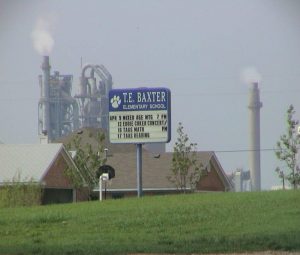Climate Change
Memo: Vote on Dallas Climate Plan Scheduled for May 27th…via Zoom?
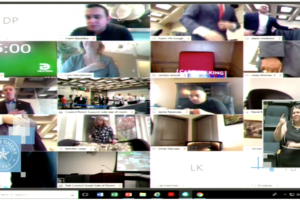 Disregarding calls to postpone a vote on its controversial Climate Plan until the Dallas City Council can resume traditional public participation in meetings, Council Environmental Chair Omar Narvaez has set a May 27th date for full council approval.
Disregarding calls to postpone a vote on its controversial Climate Plan until the Dallas City Council can resume traditional public participation in meetings, Council Environmental Chair Omar Narvaez has set a May 27th date for full council approval.
According to an April 9th memo Narvaez sent to the rest of the Council, the newest draft of the plan will be unveiled online on April 21st with a full briefing to the Environmental And Sustainability Committee scheduled on May 4th if that’s possible. If not, the full council will get a briefing on either May 6th or 20th.
While current local Shelter-in-Place orders expire at the end of April, most experts believe those should be extended through May and there’s no timeline for reinstating in-person public meetings of any local city councils or other governing bodies. If the City follows Narvaez’ schedule, it’s uncertain under what circumstances the Dallas Plan would be adopted, and how much public participation would be allowed.
That Dallas’ plan might be approved while by-passing the usual democratic niceties is just one more way it’s managed to elude real public engagement and transparency over the past two years. From beginning to end, the project has been a consultant and staff-led exercise with just enough of a thin veneer of “public participation” to reassure the unaware.
[pdf-embedder url=”https://www.downwindersatrisk.org/wp-content/uploads/2020/04/CECAP-memo_040910.pdf” title=”CECAP memo_040910″]
In the memo, Narvaez goes to great lengths to recap City Hall’s efforts at including “the public” in the plan. He cites the plan’s Stakeholder process, where staff hand-picked its own City Hall-friendly review committee. Not cited is the strange fact that there’s never been a list of individual stakeholder participants released and anyone wanting to know who was representing “the public” in the process had to submit an Texas Open Records Act request to City Hall to find out. Navarez also recounts the previous briefings his Committee has received from staff – but not the fact that no public participation was allowed in those briefings.
Neither does Narvaez mention that some of the Plan’s own official stakeholders are in open rebellion over its uninspiring results, including allies who were practically embedded with city staff for months. There are at least two separate on-going efforts by former stakeholders to try and strengthen the Plan before passage.
But the same divisions that have plagued Dallas environmental groups since the Plan’s announcement are dividing it at the end of the process as well. Representatives of larger mainstream groups like the Sierra Club and Public Citizen are pushing for quick adoption of the Plan, while Texas Campaign for the Environment, the local fledgling Sunrise Movement chapter, and others are seeking delay until citizens are allowed to come back into the Council Chambers and speak directly to their representatives – without the help of Zoom.
One recent development of the Plan that could be actually be relevant for ordinary residents is talk about restoring the Environmental Health Commission as a way to monitor the Climate Plan’s progress as well as serve as a new forum for residents’ concerns. Eliminated ten years ago just as secret gas drilling deals were being written by then City Manager Mary Suhm, the Commission had previously acted as the Council’s eyes and ears on all things related to public health and successfully advanced policy on a variety of fronts, including practical elimination of all waste incineration in Dallas.
Downwinder allies in The Southern Sector Rising Campaign for Environmental Justice called for restoration of the Environmental Health Commission last year at its March 20th news conference at City Hall and has been lobbying to bring it back ever since. Responding to a 2019 Dallas Green Alliance questionnaire, 10 of 15 current Council Members approved of the idea, so theoretically at least, it might be an easy sell.
If restoration of the Commission as previously fully empowered were to actually be included in a final Climate Plan package, at least something of practical real word use would have been purchased with the $500,000 + spent to date on the effort.
Our past coverage of the plan:
February 2019: “All Plan, No Action: Dallas City Hall’s Approach to Climate Change”
March 2019: “Dallas Climate Plan’s ‘Public Participation’ is Neither Very Public nor Participatory”
May 2019: “Dallas’ Climate Plan Rolls Out Public Engagement Plan. Public is MIA.”
November 2019: “The Only Thing Missing in Dallas’ Climate Plan “Focus on Equity” is…any measure of Equity”
February 2020: “How the Dallas Climate Plan Baits and Switches on Air Pollution”
March 2020: “Biggest Disappointment of the Dallas Climate Plan? Greens Giving Away Their Power For So Little in Return.“
How the Dallas Climate Plan Baits and Switches on Air Pollution

A little after 5 pm Monday February 3rd, the Office of Environmental Quality and Sustainability (OEQS) at Dallas City Hall released its draft recommendations for the city’s climate “action” plan. There are 93 “action items” including transportation, buildings, green spaces, water management, solid waste, and urban agriculture. Most are without imagination or timelines, meaning that even the most milk toast-like recommendations being made will have to be fought for tooth and nail to be done in a timely manner.
Like the department that generated them, the list of recommendations is effusive about stormwater management and tree-planting and silent on more challenging issues such as inequitable pollution burdens and the City’s own reliance on natural gas. It once again puts the spotlight on the lack of any environmental health expertise at Dallas City Hall in the decision-making process. When Dallas OEQS staff talk about the environment, what they really mean is “conservation” – a definition that’s been obsolete since at least the 1970’s.
There’s no better example of how this tunnel vision affects policy than OEQS staff invoking DFW’s chronically poor air quality (i.e. an environmental health problem) to sell the need for its Climate Plan…only to see the actual Plan ignore poor air quality as a serious health issue that could use some innovative thinking.
For over a year now, anytime you saw a Climate Plan presentation by Dallas OEQS staff, it always cited DFW’s smog problem as something that would only get worse as the climate crisis played out. “Everyone here is probably aware of DFW’s longtime air quality problems” or some approximate was the standard riff. And of course, everybody was. Heads nodded. Audience members were sometimes asked if they knew anyone with asthma and hands immediately shot up. That was the point. The selling point.
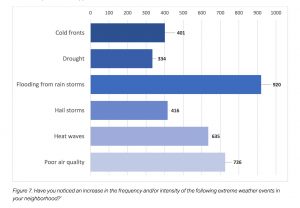 Because, until recently at least, the abstract nature of “the climate crisis” made it difficult to get people excited about the idea of a plan. Staff/Consultants needed a hook. And that hook was something everyone could relate to and probably already knew about: DFW’s three decades of violating the Clean Air Act. If you look at the results of the Ctiy’s online survey asking about frequency or intensity of climate change effects, “Poor Air Quality” was the second most cited concern. Among the City’s own handpicked crew of “stakeholders” advisors, it tied for first, along with buildings/energy use, getting more votes than parks, “nature-based approaches,” and renewable energy.
Because, until recently at least, the abstract nature of “the climate crisis” made it difficult to get people excited about the idea of a plan. Staff/Consultants needed a hook. And that hook was something everyone could relate to and probably already knew about: DFW’s three decades of violating the Clean Air Act. If you look at the results of the Ctiy’s online survey asking about frequency or intensity of climate change effects, “Poor Air Quality” was the second most cited concern. Among the City’s own handpicked crew of “stakeholders” advisors, it tied for first, along with buildings/energy use, getting more votes than parks, “nature-based approaches,” and renewable energy.
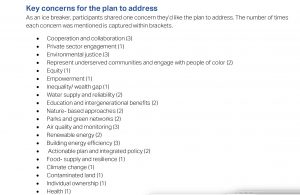
And yet, in those same City Staff presentations that highlighted poor air quality as a reason to have a Climate Plan, air quality itself was completely absent in the staff’s list of anticipated recommendations. It wasn’t that they just didn’t have much to say. They had nothing to say. There wasn’t even a category for air quality.
So Downwinders complained. Loudly. Staff and consultants sprang into action and came up with a category of recommendations officially called…“Other,” the theme of which was “air quality standards” and “public education.” Opportunities cited included “location-specific initiatives (e.g. downtown)” and “Programs targeted outdoor workers (e.g. Landscapers, construction workers).”
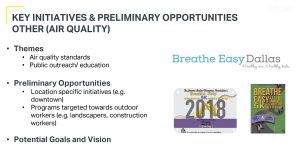 So sure, we have a chronic air pollution problem that warrants a $500,000 consultancy fee to construct a plan, but in that plan we’re only going to continue to inform people of that problem and maybe do some kind of vague thing relating to the poor souls who work outside (limit hours, hand-out free oxygen, help find new employment, or maybe free health check-ups? Doesn’t give a hint). By the way, only the public education part of that slide made it to last Monday. Construction workers and landscapers are still up a creek.
So sure, we have a chronic air pollution problem that warrants a $500,000 consultancy fee to construct a plan, but in that plan we’re only going to continue to inform people of that problem and maybe do some kind of vague thing relating to the poor souls who work outside (limit hours, hand-out free oxygen, help find new employment, or maybe free health check-ups? Doesn’t give a hint). By the way, only the public education part of that slide made it to last Monday. Construction workers and landscapers are still up a creek.
Along with those snippets of text on the “Other” slide were large color pictures of the “Breathe Easy” 5K run sponsored by The Jerome Alston Memorial Foundation in May…during Ozone Season. We’ll give the City staff credit. In terms of public education, there might not be a better way to personalize the seriousness of DFW’s air pollution problem than having North Texas smog cause an emergency asthma attack while you’re running in it. But liability could be an issue.
As late as the final round of public meetings last Fall, staff still didn’t have an “Air Quality” category but said they would have “something” when the plan was published.
Turns out “something” looks a lot like nothing.
Among the 93 “actions” listed in the Plan’s draft, the category of Solid Waste gets nine recommendations. Water Resources 15. Urban Ag 14. The brand new category of “Air Quality” has four – the fewest of any category in the plan. It’s practically stamping “Last-Minute Desperation” on the whole subject.
And tell us if any of these recommendations sound like anything you might have already heard about…
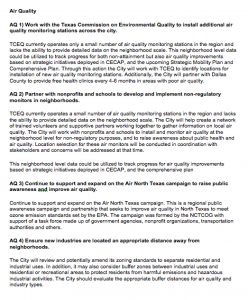
Let’s take them from the top.
The very first thing out of the gate, the lead-off, sexiest, out-of-the-box recommendation for improving air quality is…. somehow talk the State into adding more obsolete, state-run air monitors at some unspecified time in the future.
If you can, forget that the State environmental agency – the Texas Commission on Environmental Quality (TCEQ) – is a model for the Trump Administration. Forget that its official position is that smog is waaaaay overrated as a health threat. In other words, forget that this is akin to hiring Charlie Sheen to babysit your only child.
It’s not the baked-in, in-your-face cynicism of City staff knowing the state has every reason not to do this that’s so offensive. It’s the same cynicism applied to knowing full well what will happen even if the state says yes to the request: no real improvement in local information about air quality. Those state monitors are big, slow, and sparse. They run two hours or more behind real time. They’re hard to find online. They’re needlessly expensive and take up lots of real estate that has to be purchased. Their placement is decided by TCEQ and city staff, not the communities most in need of them. There is no stated OEQS goal for the number of monitors to acquire, or suggestions about where new monitors should be. No language in the recommendation about wanting real time monitoring or more modern equipment. It’s just an expansion of an already-obsolete system the state only runs because federal law requires them to (for now).
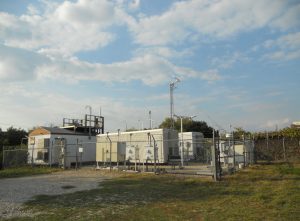
OEQS wants more of these lumbering and obsolete monitors from the state.
So let’s say the City talks the state into doubling the number of state PM 2.5 monitors in Dallas. Victory! The discussion will then be where to place the second slow, hard-to-find PM monitor for all of Dallas County’s 2.5 million residents.
Left unsaid in this recommendation is something we already know. For a year now Staff has tried to move that single Dallas County PM monitor located on Hinton Street north of Downtown to somewhere in Southern Dallas. Apparently the state has made that hard-to-impossible and so for the purposes of having something, anything, to recommend for this climate plan, staff recommends more monitors – knowing there’s a snowball chance in Hell of getting them. It’s the perfect bureaucratic out.
Most importantly the City remains a spectator to the reporting to its residents of how bad their air is. Its staff doesn’t have to make any environmental health judgments as they’re busy promoting tree planting. They leave that up to the people who couldn’t care less about how much pollution you’re breathing.
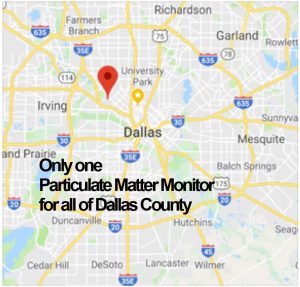
In the wake of recent Gulf Coast chemical plant accidents, the TCEQ is under heavy criticism for its lack of current air monitoring technology. The system it operates in DFW hasn’t changed in over 20 years. TCEQ won’t even put an air monitor in the only DFW “non-attainment” county that doesn’t have one – Wise – where smog levels have been predicted to be even higher than in DFW proper.
Recommending a modest expansion of circa-1999 technology is the opposite of a “best practices” answer for our gap in local air quality knowledge. The most alarming thing about this recommendation is that it got made at all.
The one-liner stapled at the end about offering free health screenings “with Dallas County” (who’s already in the business) in “areas with poor air quality” is incredibly condescending. Here’s the ultimate “settlement house” approach to a social ill – addressing the symptoms but not the cause. “Well, we can’t do much to enforce code or keep those batch plants out of your backyard, but by God we’ll be around every 6 months to keep track of your asthma until you die from it.”
How does OEQS staff know where those “areas with poor air quality” are now unless they’re out monitoring them? Which they clearly do not want to do. Given there’s only one official PM monitor for all of Dallas County, how are they defining “areas with bad air?” If they’re making educated guesses where those “areas” are based on other factors besides monitoring, why not name those factors and the “areas?” OEQS goes out of its way to avoid using the words “environmental justice” even as it makes recommendations based on the concept.
Recommendation #2 – let’s build our own “non-regulatory” air monitoring network sometime in the unspecified future with unspecified non-profits and community partner volunteers and put an unspecified number of monitors in unspecified places, for which we unspecified criteria. And these monitors “could be used to “to track progress for air quality improvements based on strategic initiatives deployed in CECAP, and the comprehensive plan.”
This is actually a great idea. It’s such a great idea that a specified alliance of local governments, non-profits, and community partners are already doing it in specified locations with specified monitors. Their effort is about to deploy over 100 locally-built air monitors that will increase PM 2.5 monitoring in Dallas County by 4000%. It’s called the SharedAirDFW Community Air Quality Monitoring Network and the City of Dallas officially walked out of it last year over a public participation requirement and a desire to refrain from being the source of bad news about bad air.
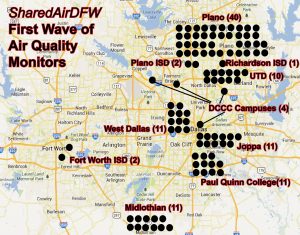
Dallas city staff is consistent in believing that telling you about air pollution is absolutely, positively necessary – they just want someone else to do it.
Having walked away from the SharedAirDFW network, OEQS set out to make one up of its own using the City Hall-friendly Nature Conservancy as its non-profit partner. The “Breath Easy” plan was to put 9-12 PM and smog monitors on the same number of DISD campuses, grow trees and implement anti-idling zones at those schools and see if asthma attacks/rates dropped in 24 months (2 growing cycles). Everyone seemed to agree how important a project this was and the city raised $500,000 or more to buy 12 very nice Aeroqual (Recommended by Downwinders since 2017!) air monitors. Everyone but the Dallas independent School District, who nixed the idea last summer. This detail somehow escaped the presentation staff gave to the City Council’s Quality of Life Committee on the Breath Easy project in September 2018.
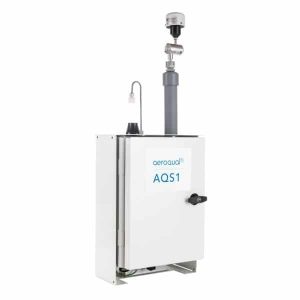
An Aeroqual stationary air monitor like the 12 Dallas owns…but isn’t using
So far the City of Dallas is 0 for 2 in making their own recommendation a reality when it had the chance. But wait! Remember those 12 monitors the City bought for the defunct Breathe Easy project? They’re just sitting somewhere. They’re already paid for but aren’t being used. OEQS could implement this recommendation of theirs on its own tomorrow if it wanted to by placing these 12 monitors in locations based on where the most industrial facilities are and where the most air pollution complaints come from. Overnight it could have its own fleet of “non-regulatory” monitors in the field, with all the benefits cited by staff.
But there’s no mention of those 12 monitors, or of the City Hall’s ability to accomplish this goal on its own, right now, without waiting. Because it doesn’t want to. It wants someone else to do it.
Recommendation #3 . It’s that forlorn public awareness recommendation showing up in the form of continued support for an ozone season air quality campaign run by a group that did its part to make smog an issue for years. There’s no harm to this but there’s also no help. This campaign will go on for as long as DFW is in violation of the Clean Air Act and doesn’t mention climate change.
Finally, there’s recommendation #4. Perhaps (but perhaps not) heavy industry that pollutes a lot shouldn’t be close to homes. This is coming straight-faced from a OEQS that’s approved the last four batch plants seeking permits to set-up shop in Joppa and the South Central Corridor…next to homes. Do as we recommend, not as we actually, you know, do.
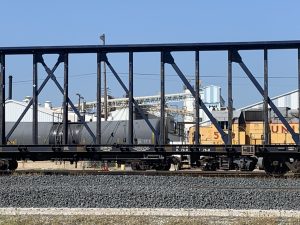
The TAMKO asphalt shingles plant and multiple diesel locomotives operate next to Austin’s asphalt batch plant…and residents in Joppa
When it says the City will review zoning, that’s not a special environmental health screening of sites. It’s just part of upcoming land use planning processes that will already be used to re-examine all zoning on a neighborhood-by-neighborhood level. They’re riding coat tails. The OEQS doesn’t make recommendations about suggested buffer zones, where those zones should be, or what criteria the city should use in pursuing buffer zones. And it doesn’t even say the City’s neighborhoods need any buffer zones between homes and industries at all, just that it may want to consider them at an unspecified time by an unspecified body for unspecified neighborhoods. Have we mentioned the staff at City Hall really really doesn’t like to deal with environmental health issues?
We get it. They had to have something or you’d be reading our criticism about the absence of ANY specific air quality recommendations, no matter how lame. And there are other items in other categories that will inevitably produce decreases in air pollution of all kinds – bus and vehicle fleet electrification being among the lowest-hanging fruit.
But City Hall’s cynical use of DFW’s air pollution problem to win support for a plan that ends up doing nothing about it directly makes these “Air Quality” recommendations particularly contemptuous.
What would more sincere “air quality” recommendations look like?
1. Acknowledging an historic imbalance in the air pollution burdens borne by Dallas neighborhoods and a commitment with a deadline to inventory the City’s air pollution threats by council district and zip code. You c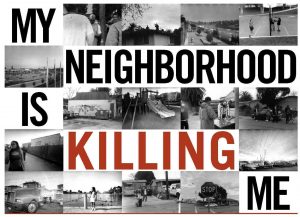 an’t fix what you don’t measure. Right now there’s no map of where concentrations of air pollution are in Dallas.
an’t fix what you don’t measure. Right now there’s no map of where concentrations of air pollution are in Dallas.
2. Acknowledging there’s no safe level of PM air pollution, i.e., no amount of exposure that isn’t capable of doing harm. Acknowledging People of Color are exposed to more, and higher levels of PM pollution than their white peers. These conclusions, supported by a multitude of good studies, including ones from EPA, are basic in prioritizing where to reduce air pollution in Dallas.
3. Recommendation to write an Environmental Equity Provision into City Code to discourage and prohibit siting new polluters in those zip codes hosting more permitted polluters than the citywide average, beginning in 2021.
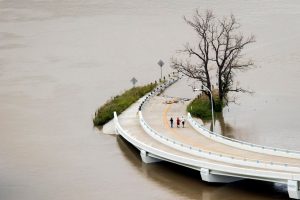 4. Recommendation to quit siting polluters in any floodplain beginning in 2021.
4. Recommendation to quit siting polluters in any floodplain beginning in 2021.
5. Recommend a 2025 deadline for the electrification of all railroad switch yard operations in Dallas.
6. Recommend 1500 foot buffer zones on either side of new major highways where homes, day care centers, and schools would be prohibited from locating. Applied to existing highways as uses within 1000 feet come up for new permits and zoning.

7. Recommend the immediate amortization and relocation of the GAF asphalt shingle factory in West Dallas and the TAMKO shingle factory in Joppa. These factories are among the City’s largest industrial polluters in Dallas, accounting for over 420 tons of air pollution in 2017 alone. They operate in the middle of dense urban residential areas populated primarily by People of Color. They need to be relocated elsewhere. Building new facilities will automatically trigger modern pollution controls requirements. They’ll be cleaner and doing business in a less harmful location.
8. Recommendation to rewrite city codes giving incentives for cleaner industries and more requirements for dirty ones.
9. Join UTD’s SharedAirDFW Community Air Monitoring Network – plug OEQS’ 12 unused monitors into the Network and begin to take responsibility for telling Dallas residents what their air quality actually is.
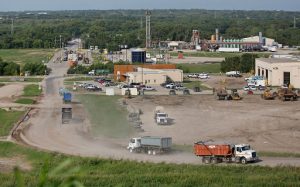 10. Acknowledge the conflict of interest the City has in producing and selling gas from its landfill recovery operation and commit to electrification of all city-owned vehicles by 2025. Dallas’ own city-run McCommas Bluff methane gas recovery facility is the fourth largest air polluter in Dallas, releasing over 160 tons of air pollution in 2017 alone. Recommend contracting only with electric vehicle fleets for additional services. Los Angeles recently committed to an all electric garbage truck fleet in five years, and Dallas could do the same – but it still wants to use its own landfill gas to power combustion vehicles.
10. Acknowledge the conflict of interest the City has in producing and selling gas from its landfill recovery operation and commit to electrification of all city-owned vehicles by 2025. Dallas’ own city-run McCommas Bluff methane gas recovery facility is the fourth largest air polluter in Dallas, releasing over 160 tons of air pollution in 2017 alone. Recommend contracting only with electric vehicle fleets for additional services. Los Angeles recently committed to an all electric garbage truck fleet in five years, and Dallas could do the same – but it still wants to use its own landfill gas to power combustion vehicles.
11. Implement stronger enforcement of the city air quality and nuisance ordinances, including hiring new staff and publicizing how to request an investigation.
12. Beginning in 2025 begin collecting municipal clean air mitigation fees of $50 a pound on permitted air pollution from major sources to incentivize pollution controls and pay for new staff. In 2017 such a fee would have collected over $1 million.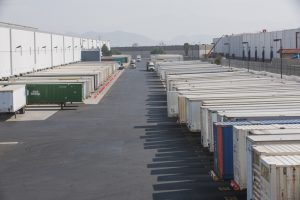
13. Implement no idling zones in all Dallas warehouse districts.
14. Recommend Low-Emission Zones in Downtown Dallas where combustion vehicles are banned or restricted, permanently or on a schedule. Consider expanding to other parts of Dallas such as Deep Ellum and Bishop Arts where congestion is already a problem.
15. Recommend PM pollution protection be designed into new bus shelters.
16. Recommend establishment of an Electric Bus Procurement Pool with DISD, DART, Trinity Metro, other area schools districts, and transit companies for cheaper purchases of electric buses.
17. Restoration of t he Dallas Environmental Health Commission.
he Dallas Environmental Health Commission.
18. Hiring a City of Dallas Environmental Health Scientist.
DFW does have a chronic bad air problem. The Climate Crisis will make it worse. It is a legitimate area of policy planning in any thoughtful, modern Climate Plan.
Just not this one.
The Only Thing Missing in Dallas’ Climate Plan “Focus on Equity” is…any measure of Equity
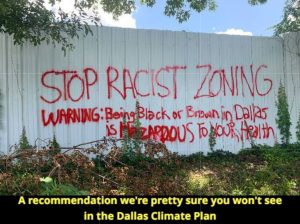
A staff presentation focusing on Dallas environmental equity lacks any metrics for comparing residential pollution burdens, or even for measuring the success of its own outreach effort.
So how does City Hall know what environmental “equity” looks like?
According to management guru Peter Drucker, “If you can’t measure it, you can’t improve it.”
Then what does it mean that a full year into a Dallas climate planning process heavily touted as reflecting the city’s emphasis on “equity” there’s still no map showing how pollution burdens are distributed across Big D? And what does it tell you when a presentation meant to advertise the inclusiveness of the City’s outreach effort for its climate plan doesn’t document participation by residents of color?
It tells you that despite all the rhetoric on the subject, Dallas City Hall isn’t serious about environmental justice yet.
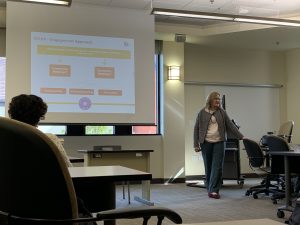
Office of Environmental Quality and Sustainability Susan Alvarez presents the City’s climate plan through “an equity lens.”
Exhibit A: “Dallas’ Climate Action Through an Equity Lens.” 



This was a presentation that Susan Alvarez, Assistant Director of the City of Dallas Office of Environmental Quality & Sustainability, gave as part of Eastfield College’s Sustainability as a Social Justice Practice: Developing Resilient Strategies held last Friday, November 8th.
Context is everything and so it’s important to note that the entire thrust of both the Conference and the City’s specific presentation was aimed squarely at how to respond to current environmental challenges in an equitable and just way. Here was a chance for Dallas OEQS city staff to display their embrace of equity as it relates to the climate plan it’s been paying a half-million dollars to consultants to construct. It was their very own EJ report card.
Equity and the Climate Plan:
And sure enough, there was no turning away from Dallas’ racist history in Alvarez’ presentation. Maps showing the City’s chronic segregation and poverty were included, as well as allusions to the Trinity River as the city’s dividing line between Haves and Have-Nots. Alvarez spoke about the current “Redlining Dallas” exhibit at City Hall that traces the City’s history of racism across 50 feet of photographs and stories.
In fact, just about every impact of the City’s official segregation was referenced, except for the one you’d expect.
There was not a single slide or sentence expended on the disproportional environmental impacts of 100 years or more of Dallas racism. No maps of where heavy industry zoning is allowed in the City. No maps of where most of the City’s largest polluters are located. No maps of what zip codes or Council Districts have the highest pollution per capita numbers. No references to past environmental justice struggles with the City like the West Dallas RSR fight, or gas drilling.
Watching the presentation you’d get the impression that racism infected every aspect of life for Dallas residents of color except for their exposure to pollution. But of course, we know that’s not true.
During this and other presentations on the climate plan-in-progress, staff go out of their way to point out that industry makes up “only 8% of emissions.” But if you’re interested in applying “equity” to this number the next slide should show the audience where that industry is distributed in Dallas – a map showing you where industrial polluters are allowed to set-up shop. A slide to show you the amounts of permitted pollution by Zip Code, or maybe actual 2017-18 emissions by Council District. But there is no next slide.
If there were, it would show that most of that industry is located in predominantly Black and Brown neighborhoods. Racist zoning is at the heart of not just banking, education, and employment inequities in Dallas. It also means the dirtiest industries have always been located in close proximity to people who were institutionally considered Second-Class citizens.
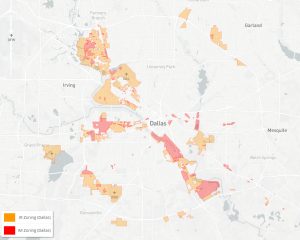
This one slide is already more information on Dallas environmental equity than you’ll find in the entire City staff presentation on equity and the climate plan
Disproportional exposure to industrial pollution by residents of color is not just AN equity issue. It’s THE single most important equity issue when you’re speaking about environmental justice in Dallas. The City’s Black and Brown residents are more likely to be exposed to harmful pollution than their white peers because the City’s own zoning designed it that way – but you’d never know it watching this presentation, on equity, at the social justice conference.
The “Redlining Dallas” exhibit that Alvarez cited thinks so. Along with other insidious effects of racism, it gives space to the RSR clean-up fight Luis Sepulveda and his West Dallas Coalition for Environmental Justice waged in the early 1990’s. But there was no mention of that fight or any other Dallas examples during the presentation on equity, at the social justice conference.
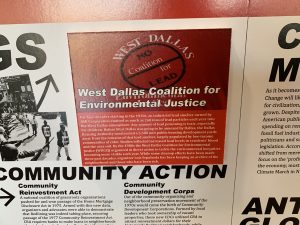
Staff referenced every other kind of red-lining on display at the City Hall exhibit – except the one most relevant to the topic.
Nor was there any mention of how much industry was located in the Trinity River floodplain, doing business in Black and Brown neighborhoods founded because the City wouldn’t allow these so-called “undesirables” to live anywhere else but side by side with “undesirable” industries. Alvarez made the point in the presentation that climate change means more flooding in general and more severe flooding. The next slide should show who and what is affected by that new flooding risk. A slide showing what percentage of heavy industry is located in the flood plain. A slide showing what the racial make-up and income levels are of those who’ll be more affected by increased flooding…and contamination. But there was no next slide, in the presentation on equity, at the social justice conference.
If you don’t have accurate maps of the inequities plaguing the status quo, how do you know when or if you’re ever getting rid of them? How do you judge success without a baseline?
PR, Process and Equity:“I don’t think it’s important to say I’ve got four black people in my stakeholders group.”
Alvarez lowered expectations for the presentation by saying it would only look at the question of equity in how it was applied to the City’s climate plan “community engagement.” No actual equity policy options from other plans were on the table, just how well the plan’s public relations campaign did.
Not very well, she admitted. In fact the initial meetings and publicity were so anemic that she said the professional PR folks at Earth X had a come-to-Jesus-meeting with staff about a reboot. So that’s tens of thousands of dollars wasted on PR consultants only to be usurped by better free advice from locals.
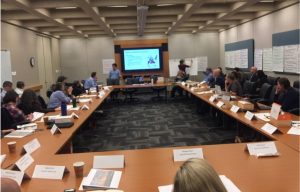
A meeting of the Dallas climate plan advisory group.
In her recounting of the climate plan’s PR rollout and planning process Alvarez gave an overview of the mechanics. “X” number of meetings attracted “X” numbers of people. The City’s survey got “X” number of responses. An “X” number of people serve on an advisory stakeholders group.
Considering the very specific circumstances of the presentation, the next slide should have been how the results of those attending meetings, or completing a surveys, or advisory committee memberships reflect Dallas’ population as a whole. How do we stack up to who we’re representing? According to the Statistical Atlas Dallas is approximately 25% Black, 41% Hispanic , 30% White and 3% Asian. So the next slide should compare what percentage of those attending climate plan meetings, or completing surveys, or becoming advisory committee members were Dallas residents of color vs the city demographics.
But there was no next slide about how inclusive the City’s climate plan community outreach or advisory process has been in the presentation on equity, at the social justice conference.
In response to a question about the lack of such information Alvarez said it was irrelevant to the topic at hand. “I don’t think it’s important to say I’ve got four black people in my stakeholders group.”
Since the advisory group membership is only listed online by organizational affiliation it’s impossible for anyone outside the meetings to know what the ethnic or gender make-up of it is. There are 39 separate entities listed. 25% of that number would be nine to ten black people.
In elaborating, Alvarez challenged the idea that mapping Dallas’ racial or ethnic disparities in pollution  burdens was necessary to understanding “Dallas’ Climate Action Through an Equity Lens.” She more or less stated it didn’t matter. (the presentation was recorded by Eastfield College and Downwinders has asked for access to it in order to quote Alvarez accurately).
burdens was necessary to understanding “Dallas’ Climate Action Through an Equity Lens.” She more or less stated it didn’t matter. (the presentation was recorded by Eastfield College and Downwinders has asked for access to it in order to quote Alvarez accurately).
Nothing could better summarize the kind of Catch-22 “don’t confuse me with the facts” approach to “equity” the City staff has taken in regards to environmental racism than the belief that actual data about Dallas environmental racism is of no use to the study or remedying of Dallas’ environmental racism.
And nothing makes a better case for the need to pass environmental justice reforms the Southern Sector Rising Campaign is advocating at Dallas City Hall, including an environmental justice provision in Dallas’ economic development policy, restoration of the Environmental Health Commission, and creation of a Joppa Environmental Preservation District. If residents want environmental equity considered in city policy they’re going to have to enlist their City Council members, do it themselves, and enact reforms like these.
The same is true as City Hall ramps up to take on citywide land-use planning in its “forwardDallas!” process early next year. When staff recently released the City’s “equity indicators” report, there was an indicator for everything but the environment. It only reinforced the idea that the environment, and environmental justice, are still after-thoughts in Dallas city government. Residents will have to arm themselves with the information the City staff can’t or won’t provide. They should start with the recent Legal Aid report “In Plain Sight” that demonstrates deep neglect for code and zoning regulations in Southern Dallas.
And it also goes for the climate plan. Southern Sector Rising’s first recommendation for the city’s climate plan last May was “Remove industrial hazards from the flood plain.” On the other hand, the idea of land use reforms in the floodplain hasn’t appeared in any official literature or presentation associated with the city’s climate plan.
Grist recently published an article about the Providence Rhode Island climate planning process that looks to be the exact opposite of the model Dallas has adopted. But that city benefited from having an environmental justice infrastructure already in place when the climate crisis assignment arrived. Where’s the home for Environmental Justice in Dallas City Hall? Right now, it’s with staff that doesn’t think metrics about equity are important, in its presentation on equity, at the social justice conference.
LafargeHolcim is a “Conscientious Corporate Citizen” Everywhere But Texas

In Europe, LafargeHolcim is a multinational cement manufacturer based in Switzerland and France – two countries on the cutting edge of climate crisis planning and members of the progressive European Union. The Company portrays itself as a climate-conscientious corporate citizen, to the point of its Swiss CEO declaring the reduction of CO2 emissions as his first, most important priority.
In Midlothian Texas, LafargeHolcim runs the most conventionally dirty cement plant in Texas and is seeking a permit that could make it one of the most climate-hostile one as well. In fact, there’s some reason to believe the Holcim plant in North Texas is preparing to burn by-products from either the Canadian Tar Sands, the Permian Oil Field, or both, as fuel.
Baking rock to make cement takes a lot of heat. Regardless of how new or old a cement kiln is, regardless of the pollution controls a kiln has, every cement maker in the world still has to employ the same age-old process of applying a 2000 degree open flame to a mix of limestone and other ingredients. A third or more of the cost of running a cement plant is keeping that open flame consistently hot enough to do the job.
This is the reason cement kilns will always try to find cheap, free, even profitable sources of fuel for that flame. Hazardous and industrial wastes that c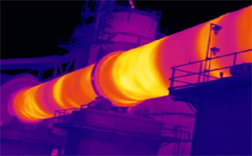 an be diverted from incinerators or landfills can be burned in cement kilns for slightly less money because they don’t have to meet the same standards. Used tires and oil. Lottery tickets. Dashboards from cars. Even municipal waste is now being burned in kilns.
an be diverted from incinerators or landfills can be burned in cement kilns for slightly less money because they don’t have to meet the same standards. Used tires and oil. Lottery tickets. Dashboards from cars. Even municipal waste is now being burned in kilns.
Burning anything causes air pollution. Burning wastes causes lots of conventional and exotic air pollution, including CO2. But just baking limestone rock also releases a lot of stored CO2. Even if there was some was to make cement without a flame, the heat needed would still release tons of CO2.
Worldwide the cement industry is estimated to be responsible for 5 to 7% of the planet’s CO2 emissions – larger then the airline industry. If the industry were a country, it would be the third largest emitter on earth, behind the United States and China.
Companies like LafargeHolcim are facing both public and financial pressures to reduce that number. In July European funds managing $2 trillion in assets called on cement companies to slash their greenhouse gas emissions, warning that a failure to do so could put their business models at risk. The mangers specifically mentioned LafargeHolcim and urged it to adopt the goal of net zero carbon emissions by 2050 and align itself with the Paris Climate Accords.
LaFarge Holcim has responded by initiating a series of technical innovations and pilot projects under the banner of “The Plant of Tomorrow” to prove its forward thinking.
Almost 300 facilities around the globe are targeted for inclusion in one or more of these “Plant of Tomorrow” projects, including a Canadian kiln installing a carbon-capture pilot project, an Ohio kiln building three wind turbines to secure its electrical needs, and kilns burning industrial waste as “low carbon” (if not low toxic) fuel.
Left out of this mix so far is Holcim’s woe-be-gone Midlothian plant. You might call it Holcim’s “Plant of Yesterday.” Despite having lots of stiff competition, Holcim not only operates the dirtiest cement plant out of the three doing business in Midlothian, but it’s the dirtiest in the entire state.
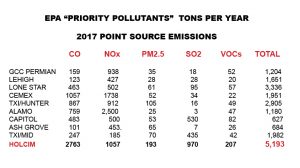
Holcim’s Midlothian plant is the largest Carbon Monoxide (CO) polluter among all 10 Texas cement plants – a sign of poor combustion. It’s the second largest Nitrogen Oxide (NOx) polluter among the bunch, emitting almost twice as much smog pollution as the other two Midlothian cement plants combined. It’s the largest PM 2.5 (Particulate Matter) polluter by far – almost 100 tons a year separate it from second place. It’s the largest Sulfur Dioxide (SO2) polluter by a large margin and releases four times as much Volatile Organic Compounds (VOCs) than the next highest plant. Almost all 2017 pollution numbers for Holcim have gone up over the last five years. A plant that was already bad is getting worse.
Now add Holcim’s request for a new permit to burn 100% Petroleum Coke in one of its two kilns.
Pet Coke is a byproduct of oil refining. It’s a concentrated carbon solid residue that is left behind after the refining process has converted the bulk of the oil into liquid fuels such as gasoline and diesel.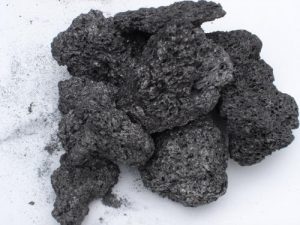
Pet Coke is like coal, but dirtier. Pet Coke looks and acts like coal, but it has even higher carbon emissions than coal. On a per-unit of energy basis Pet Coke emits 5 to 10 percent more carbon dioxide than coal. A ton of Pet Coke yields on average 53.6 percent more co2 than a ton of coal.
As well as significantly higher co2 emissions, Pet Coke also has high sulfur and toxic metals content than coal.
Because its a waste product, Pet Coke is cheap for Holcim to buy or it could even be free if a refinery wanted to get rid of its supply. And now, thanks to the exploitation of the Tar Sands and the oil boom in the Permian the US has lots and lots of Pet Coke. The heavy oil refining capacity in America is now the largest in the world, with over 40 percent of the global market. Much of that production takes place on the Texas Gulf Coast in huge new expanded refinery complexes like Motiva and Total in Port Arthur. The capacity to produce Pet Coke in U.S. refineries has doubled since 1999. In fact, the annual production of Pet Coke is so large these days, it’s outstripped most of the usual uses for it and is “priced to move.”
Because Holcim wants to burn 100% Pet Coke, and it must have a reliable source to burn it 24/7, there’s reason to believe the company has signed a sweetheart deal with one or more refineries to supply it. Probably from the Gulf Coast, and probably from one of the refineries dealing in Canadian Tar Sands oil or Permian Basin product. Both are poster boys for irresponsible fossil fuel development with the Tar Sands and the Keystone Pipeline igniting modern Climate Crisis activism and the Permian becoming one the planet’s largest sources of Methane as tons of unused natural gas are burned off from thousands of rigs.
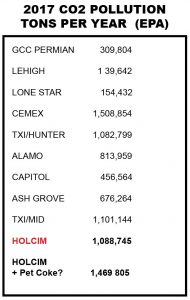 Currently, Holcim is “only” the third largest CO2 polluter among all ten cement plants in Texas, and fourth among all of Holcim’s U.S. plants. But burning 100% Pet Coke in its Kiln #2 could change that rapidly by adding a whopping 400,000 tons more of CO2 to its annual totals. That would send it to #2 in Texas and #2 in the entire US Holcim fleet of cement plants. Not very climate conscientious. And probably not a number you want to tout in trying to sell your “Plant of Tomorrow.”
Currently, Holcim is “only” the third largest CO2 polluter among all ten cement plants in Texas, and fourth among all of Holcim’s U.S. plants. But burning 100% Pet Coke in its Kiln #2 could change that rapidly by adding a whopping 400,000 tons more of CO2 to its annual totals. That would send it to #2 in Texas and #2 in the entire US Holcim fleet of cement plants. Not very climate conscientious. And probably not a number you want to tout in trying to sell your “Plant of Tomorrow.”
At the same time Holcim is trying to project an image of a concerned 21st Century corporate entity to the rest of the world, it’s doing business in Texas like its still 1999.
Officially, the State of Texas doesn’t care about CO2 pollution. Heck, officially it doesn’t even believe there’s a climate crisis. There is no regulatory system for controlling its releases and only the EPA bothers to track CO2 releases at all. So this increase in planet-melting pollution will go completely unaddressed in the permit proceedings themselves.
Also officially, despite the evidence, the State and Holcim both say no other kinds of pollution will increase when 100% Pet Coke is burned at Holcim. No increase in PM 2. 5. No increase in SO2. No increase in metals. Citizens don’t believe them. A group calling itself “Midlothian Breathes” has formed to fight the new permit and has already caught regulators off guard asking tough questions about new emissions.
But trying to get the State of Texas to do the right thing about air pollution is an uphill fight. Instead, perhaps citizens should take these embarrassing numbers directly to LafargeHolcim, who’s claims of new fund corporate responsibility are belied by them. Contrasting its Texas operations with those of the rest of its facilities may be a way to shame the company in its own European backyard. Officially the company may still be able to be embarrassed. Texas state government left that possibility behind years ago.
DFW Holcim Cement Plant Seeks to Burn 100% Petroleum Coke
Increases Predicted in Air Pollution, including 100 more tons of PM a Year
Holcim Cement’s Midlothian cement plant has requested a permit application to the Texas Commission on Environmental Quality to release an additional 2700 tons per year of Carbon Monoxide and burn 100% Petroleum Coke in its Kiln #2. Holcim estimates these change will set of federally-mandated reviews for increases in emissions of Particulate Matter (PM), Nitrogen Oxide (NOx), Sulfur Dioxide (SOx), and Carbon Monoxide (CO).
Notice of the company’s permit amendment was published in the Midlothian Mirror earlier in the  month.
month.
Holcim is one of three very large cement plants doing business just south of I-20 in Midlothian in what is the largest concentration of cement manufacturing in the U.S. The other two are TXI and Ash Grove. These are not batch plants. These are where the batch plants get their product. With annual air pollution emissions in the thousands of tons, any one of these kilns would easily be the largest “stationary” industrial source of air pollution in North Texas. Combined, they represent a mega source of air pollution for DFW.
Review of the numbers in the permit application show the company wants to scrap its current limit of a little over 4000 tons a year for Carbon Monoxide and replace it with a higher 7112 ton per year ceiling. In addition, the difference between actual emissions and proposed changes could result in 100 tons more of Particulate Matter, 260 more tons of smog-forming Nitrogen Oxide, and 1700 additional tons of Sulfur Dioxide.
 Missing from the permit analysis is the impact of the changes on CO2 climate crisis pollution. Petroleum Coke is nothing but carbon. It releases a lot of CO2 when burned. Burning 100% Petroleum Coke at Holcim will significantly increase this kind of air pollution. Cement plants are already a huge source of CO2 worldwide and Texas leads the country in CO2 pollution.
Missing from the permit analysis is the impact of the changes on CO2 climate crisis pollution. Petroleum Coke is nothing but carbon. It releases a lot of CO2 when burned. Burning 100% Petroleum Coke at Holcim will significantly increase this kind of air pollution. Cement plants are already a huge source of CO2 worldwide and Texas leads the country in CO2 pollution.
Overall, it’s the largest requested air pollution increase from any of the three Midlothian kilns in a very long time. And it reveals how badly the snake-bit 20th Century Holcim plant is aging.
Holcim’s current air pollution levels are already way out of sync with the other two, newer cement plants in Midlothian, and the Holcim facility has had a long troubled history with what its owners claim is a problem with the area limestone – the same patch of limestone the other two plants use. Holcim is already releasing 14 times the amount of four major air pollutants compared to Ash Grove’s 2014 renovated plant, and three times the amount of those same pollutants as TXI. This permit amendment would make the difference even starker.
Clearly Holcim has a problem child cement plant. Since Kiln #1 opened in 1999 it’s never performed to expectation. Because it would otherwise have set off a national non-attainment area for Sulfur Dioxide, Holcim had to add scrubbers to the plant before it even opened. When Kiln #2 was added in 2000, Holcim predicted it would cut pollution in half. Instead it doubled air pollution and by EPA decree the company had to add new pollution controls and buy Downwinders at Risk an independent scientist to monitor their operations. Now Holcim is saying their longstanding plan to reduce Carbon Monoxide pollution at that second kiln just didn’t work out and they need to increase their CO “permit allowables” by over 2700 tons a year.
Even for a very large cement plant, that’s a significant increase in pollution. CO pollution is a red flag for poor combustion, which is always worrisome when you’re looking at a facility of Holcim’s size that’s burning a flame at 2400 degree flame 24/7/365. Poor combustion at a cement plant burning tires and industrial waste, as Holcim does, or even coal and Petroleum Coke, means the creation of more “Products of Incomplete Combustion,” or “PICs.”
PICs are bad news. Dioxin – the poison in Agent Orange – is a PIC but there are thousands more. Some are extremely toxic. Holcim is already releasing 168 times more CO than the newer Ash Grove plant – located just across Highway 67, and nine times more than former Bad Boy TXI. That’s a lot of potential PICs. Something isn’t right in the basic design of the plant to make it so inefficient, but instead of investing in a new plant, Holcim just wants to increase its pollution levels.
There’s a second part of Holcim’s request that’s even more disturbing. Besides the increase in CO pollution, Holcim is seeking approval from the State to burn 100% Petroleum Coke as a fuel for its Kiln #2.
Cement kilns need a cheap source of fuel. Since 1960 the Midlothian kilns have burned gas, coal, hazardous waste, tires, used oil, car inards, plastic packaging, and other “industrial wastes” to keep a flame at 2400 degrees F or hotter. But never 100% Petroleum Coke.
Pet Coke is a refinery waste high in BTU value and sulfur content. It’s very dirty. It’s basically solid carbon. In the application submitted by Holcim, the company says Particulate Matter pollution could go up by 100 tons per year. There’s also a very good chance of increases in smog-forming Nitrogen Oxides and Sulfur Dioxide pollution. Separately there’s also a significant but undocumented increase in CO2 that will occur because of Pet Coke’s composition, so this is a very bad Climate Crisis move as well.
Holcim says not to worry – most of these increases are on paper only and they’re not really changing the emissions, just “refining them.” But with the plant’s history, it’s more likely air pollution will increase, and not by a little bit.
TCEQ’s permit engineer assigned to the Holcim case says this is only a preliminary application and that the company will have to answer more questions about pollution increases, and more importantly will have to stage a “test burn” to see what the impact of burning 100% Pet Coke will actually be (under ideal conditions when everyone is looking over their shoulder). Many long time observers of the modern TCEQ under Governor Greg Abbott are skeptical any of this will happen before Holcim gets their permit however.
Because of the increased volumes of pollutants, this application will be generating an official response from Downwinders requesting at least one public meeting for a briefing on the permit and objecting to any increase in PM and NOX, insisting on test burns using 100% Pet Coke before the permit is approved, and protesting any increase in Climate Crisis pollution.
There’s two responses you can take right now to oppose Holcim’s permit amendment:
1) You can request a public meeting in Midlothian to have the TCEQ and company brief the public on the permit amendment and have the opportunity to ask questions
CLICK HERE TO SEND AN EMAIL NOW TO THE TCEQ
AND ALL LOCAL STATE REPRESENTATIVES AND SENATORS
Requests should be addressed to the Texas Commission on Environmental Quality as well as local State Representatives and Senators – not just those representing Midlothian.
TCEQ:
By email:
https://www14.tceq.texas.gov/epic/eComment/
bbohac@tceq.state.tx.us
By mail:
TCEQ, Office of the Chief Clerk, MC-105, P.O. Box 13087 Austin, Texas 78711-3087
Texas State Senators
St. Senator Brian Birdwell/Midlothian: Brian.Birwell@senate.texas.gov, 512-463-0122
St. Senator Royce West/Southern Dallas County: royce.west@senate.texas.gov 512-463-0123
St. Senator Beverly Powell/ Southern Tarrant County: beverly.powell@senate.texas.gov 512-463-0110
Texas State Representatives
Rep. John Wray/Midlothian: john.wray@house.texas.gov 972-938-9392
Rep Yvonne Davis/ Southern Dallas County: yvonne.davis@house.texas.gov 512-463-0598
Rep. Carl Sherman/Southern Dallas County: carl.sherman@house.texas.gov 512-463-0953
Rep. Chris Turner/ Southern Tarrant County/Arlington: Chris.Turner@house.texas.gov 512-463-0574
Contact all of these folks individually, or you can send them and the TCEQ the same email requesting a public meeting on Holcim’s permt via Downwinders’ ClickNSend feature. Leave your own personal message too.
2) Request a Contested Case Hearing
If you feel you’ll be affected by Holcim’s new air pollution, you have a right to ask for a contested case hearing – a formal legal proceeding that sets a higher bar for Holcim to get a permit. In order to request a Contested Case hearing, you must send the TCEQ Chief Clerk:
1) YOUR NAME, or GROUP NAME
2) MAILING ADDRESS AND TEL #
3) APPLICANT’S NAME AND PERMIT #: Holcim, Air Quality Permit 8996 and PSDTX454M5
4) THIS EXACT STATEMENT: ” I/We request a contested case hearing.”
5) A DESCRIPTION OF HOW YOU WILL BE HARMED BY HOLCIM’S AIR POLLUTION
6) THE LOCATION OF YOUR HOME OR BUSINESS AND THE APPROXIMATE DISTANCE TO THE HOLCIM CEMENT PLANT TO THEM.
7) A DESCRIPTION OF HOW YOU USE THE PROPERTY AFFECTED BY HOLCIM’S AIR POLLUTION (HOME OR BUSINESS OR RECREATIONAL)
8) A LIST OF DISPUTED ISSUES
Example: 1. Any increase in PM Pollution from Holcim will be harmful to my health and enjoyment of my property, 2. There has been no evaluation of the PM, NOx, SOx, or CO emissions of burning 100% Petroleum Coke in Kiln #2, 3. There has been no evaluation of the burning 100% Petroleum Coke in Kiln #2 on increase in CO2 4. Holcim’s cement plant isn’t applying Best Practices and Best Available Control Technology for emission reductions of PM, CO, NOx, and SOx.
Send your request to the TCEQ’s Chief Clerk:
By email:
https://www14.tceq.texas.gov/epic/eComment/
bbohac@tceq.state.tx.us
By mail:
TCEQ, Office of the Chief Clerk, MC-105, P.O. Box 13087 Austin, Texas 78711-3087
Dallas’ Climate Plan Rolls Out Public Engagement Plan. Public is MIA.

They had the PowerPoints. They had the hardcopies of the PowerPoints in Spanish. They had the Subject Boards. They had the Post It notes and purple dots. Lots of purple dots. They had staff. They had consultants. They had consultants hired by consultants.
All in all, Dallas City Hall had everything it thought it needed for its very first of six climate plan public engagement meetings…save the public itself.
Of the 23 people in attendance on April 29th at the Beckley Saner Rec Center, only three were members of “the public.” Staff and consultants outnumbered them a good five to six to one with the rest being members of the City Climate Plan’s handpicked “Stakeholders Group.”
And even that group was not a safe bet. One Stakeholder came armed with a flier complaining that the City had made “no promise your voice or ideas will actually be heard” while another wondered why there were being asked to attend. That was a easy question. To help fill seats.
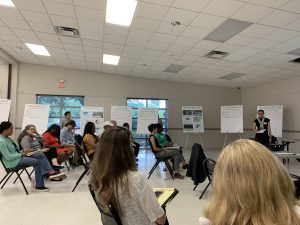
Looks can be deceiving. There were only two members of the public at the first climate plan public meeting. Everyone else in this picture is staff or Stakeholders.
It wasn’t a very auspicious beginning to the public interface phase of the city’s climate plan process. It’ll be interesting to see how much the city gets billed by the professional PR experts to generate less than a Poker game’s worth of participants.
That result prompted a memo which produced wave upon wave of new social media reminders about the great opportunity to attend the next five meetings from everyone at City Hall including, council members, Dallas Mayor Mike Rawlings to DART board members. That push was successful in tripling the size of the April 30th and May 2nd meetings to nine members of the public. But there hasn’t been a meeting yet where the public made-up a majority of those in attendance.
Maybe word got out about the, er, circumscribed nature of the “engagement” meetings. You arrive to find the categories for responses have already been defined by staff on big white boards surrounding the room. There’s “Buildings and Energy,” “Food and Urban Agriculture,” “Parks and Open Spaces,” “Solid Waste,” “The Water We Use,” and “Transportation.”
These follow the format of the online survey the City is pimping.
Missing are topics like “Air Quality,” “Flood Control,” “Zoning” and “Industry.”
Under each of these broad subject titles are exactly six prompted policy options already proposed by staff. Not five, or seven, always six. And they’re far from comprehensive. For example, despite the worldwide wave of electric bus fleet electrification (Paris just ordered 800 e-buses), that policy option is nowhere to be found on the Transportation Board. If you’re aware of that trend you can record a write-in vote for it but it’s not presented to the general public as an obvious climate change policy, which it most certainly is.
Otherwise, your job is to place purple dots by the policy options already outlined for you by City Hall staff.
This is after you get a 30-minute Dallas staff PowerPoint primer on climate change that tells most people showing up for this meeting what they already know. There’s never any opportunity for a back and forth discussion among participants or true brainstorming as a group about local remedies. You watch the PowerPoint, pick among the already chosen policy options on the big boards, or write your own suggestions in, and then….go home. This is the staff’s definition of “public engagement.”
Setting the tone-deaf basis for these public engagement meetings was the much ballyhooed “Town Hall” at this year’s Fair Park’s EarthX event, which was really just one looooong lecture. There you could immerse yourself in 45 minutes of staff talking at you about how great staff and Dallas had been doing so far. Want to ask questions about the process? No time. It was less a “town hall” than a “city closet.”
A good fifth or fourth of the Town Hall audience were Stakeholders already chosen by the city staff to participate in a sort of overview of what’s going on. These are the same Chosen Few who were asked to please show up at the public engagement meetings. There is no public listing of who’s in the group – it’s not there on the City’s website or anywhere else, but it looks to include all the usual suspects we predicted it would plus a few others. There’s also not a meeting schedule for the group or an indication whether the public is allowed to attend.
In fact, the City’s climate plan website is kind of a hot mess, full of 404 error messages and empty white space where details of the process should be housed. A question on the site’s “forum” asking about Stakeholder membership has gone unanswered for 6 days now. It’s “blog” is empty of posts. Like the process itself, it seems mostly for show and to serve as a funnel to take the city’s survey.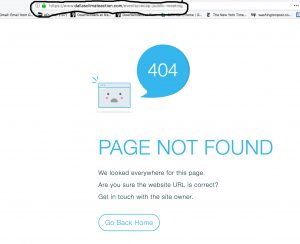
Official Stakeholders are sometimes asked to identify themselves in the meetings, but never actually introduce themselves to the public. They’re supposed to be a combination of business, government, and environmental group representatives but since there’s no listing of them, it’s hard to tell how representative they really are. During their first group meeting, the guy from the Trump EPA reportedly looked around the room and commented how “white the group was.” Not a good sign.
Nor do they seem to have much opportunity for real input. Stakeholders complained at the April 29th meeting that either that they hadn’t been asked to provide suggestions for the City’s survey and meeting format or the ones they’d offered were ignored.
So far, they’ve mostly served the purpose of filling out the very thin public presence at each of the City’s official climate plan events and being a PR backstop for staff to proclaim how inclusive they’re being.
We hate to say we told you so, but we really did.
There are three more city “public engagement” meetings scheduled if you want to assess the process for yourself:
MONDAY, MAY 6
Churchill Rec Center
6906 Churchill Way
6:00 – 8:00 p.m.
TUESDAY, MAY 7
Audelia Rd Library
10045 Audelia Rd
6:00 – 8:00 p.m.
THURSDAY, MAY 9
Eastfield College- Pleasant Grove
802 S. Buckner Rd,
6:00 – 8:00 p.m
Dallas Climate Plan’s “Public Participation” is Neither Very Public nor Participatory
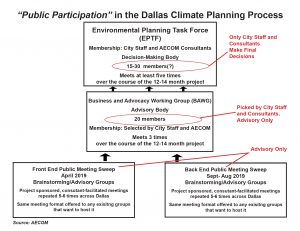
Despite supporters’ claims that the new $500,000 Dallas Climate “Action” Plan would have lots of opportunities for public participation, the decision-making apparatus drafting the plan puts all the decision-making power in the hands of City staff and its hired consultants.
Meet the New Boss. Same as the Old Boss.
Oh, they’ll be countless PowerPoint presentations and “brain storming” sessions around the city over the next year in meetings sponsored by City Hall and neighborhood associations, but those will have exactly zero official standing in the final plan. Suggestions and comments will be harvested but they don’t have to be included – not even if they’re extremely popular in all those meetings.
Those community meetings are the foundation for the process AECOM consultants outlined at the City’s Climate Symposium on February 4th. They’re at the very bottom of the plan’s purported decision-making pyramid. This MO is familiar to anyone dealing with Dallas City Hall in the recent past: “We’re happy to give you all the well-publicized public meetings you want. Just don’t ask us to let the public in the room when the actual decisions are being made.”
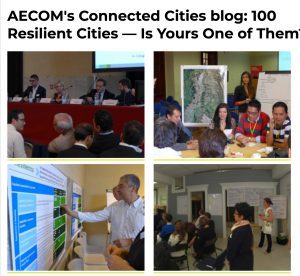 To maintain the illusion of someone other than city staff and consultants being involved, there’s a 20 member “Business and Advocacy Working Group, or “BAWG” (pronounced like the noun describing the soft ground formed by decaying plants, but also like the British slang term for a toilet, as in “Do you have any Bog/BAWG paper? We ran out.” Either metaphor is probably apt here.)
To maintain the illusion of someone other than city staff and consultants being involved, there’s a 20 member “Business and Advocacy Working Group, or “BAWG” (pronounced like the noun describing the soft ground formed by decaying plants, but also like the British slang term for a toilet, as in “Do you have any Bog/BAWG paper? We ran out.” Either metaphor is probably apt here.)
This august body will be, let’s see, what was the very civilized term used by the AECOM consultant at the Symposium? “Curated,” that’s it. The BAWG members will be “curated” by city staff and AECOM. We thought that was such a precious term for “hand-picked by the Powers-That-Be.”
So City Hall and AECOM will hand pick the 20 members of this working group, at least half of whom will be Dallas “Bidness” folk. That leaves 10 or less slots for “advocates” like the Texas Tree Foundation, the Texas Nature Conservancy, and other City Hall friendly-groups who are allies or have the blessing of Dallas (Rockefeller) “Resilency” Czarina Theresa O’Donnell. Of course O’Donnell proved her green bone fides earlier this decade when she passionately defended the idea of drilling for gas in Dallas public parks.
Despite other cities singling-out “equity” concerns for their own tracks, there’s absolutely official zero intent in the Dallas Office of Environmental Quality and (Rockefeller) Sustainability to do so here. Not even after going around the last six months proclaiming how concerned City Hall was about black kids with asthma. Local environmental justice advocates approached the OEQ(R)S last month with the idea of establishing an “equity working group” as part of the public participation process. They were told the City wasn’t interested.
Remaining remarkably consistent with their current management philosophy city staff dismissed the idea that more Dallas residents being involved in the planning process was a good thing. When the EJ groups brought up the recently-completed San Antonio plan which established not only a business-environmentalist steering committee but working groups on “Energy and Buildings,” “Transportation and Land Use,” “Solid Waste Resources, ” Water and Natural Resources,” and “Equity,” staff responded that San Antonio City Hall had warned them to avoid all that democracy. “There were too many people involved down there” was the reply, which will surely come as a surprise to the 86 San Antonio activists who participated.
Despite all this official gate-keeping surrounding the Climate Plan’s BAWG/BOG membership in Dallas, the actual on-the-paper influence of this curated working group is questionable since it only meets 3 times over the course of the year long drafting process. For most of those 12 months this “working group” is unemployed.
Which brings us to the real decision-makers at the top of the pyramid, the “Environmental Planning Task Force, or “EPTF.” Gesundheit!
Comprised exclusively of city staffers and consultants, this Task Force will oversee the day-to-day machinations of the climate plan, and most importantly what recommendations to include, or not, and what timelines are “realistic” vs “not practical.” While there’s a patina of public participation in its “listening tours” the final arbiters of Dallas’ climate plan remain completely removed from public transparency, accountability and meaningful participation.
It didn’t have to be this way, at least not without a fight.
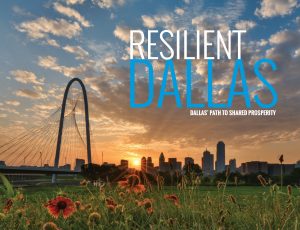 The same mainstream green groups that signed-off on City Hall using Dallas’ moribund plastic bag fund to pay for this plan could have demanded authentic public participation in return for their support. They could have asked for Southern Sector groups to have their fair share of representation at the table. They could have requested multiple resident-staffed working groups like San Antonio. They could have asked for real oversight and decision-making. Dallas City Hall needed them and their lobbying last August during the budget town hall meetings, but they gave up their leverage without asking for anything in return (that we know about anyway). This current public participation plan that really isn’t, is the result.
The same mainstream green groups that signed-off on City Hall using Dallas’ moribund plastic bag fund to pay for this plan could have demanded authentic public participation in return for their support. They could have asked for Southern Sector groups to have their fair share of representation at the table. They could have requested multiple resident-staffed working groups like San Antonio. They could have asked for real oversight and decision-making. Dallas City Hall needed them and their lobbying last August during the budget town hall meetings, but they gave up their leverage without asking for anything in return (that we know about anyway). This current public participation plan that really isn’t, is the result.
As we noted in our last post about this subject, perhaps the only good thing about this process is that’s it gives Dallas residents a chance to upset the cart with their own ideas about how a climate plan for the city should be assembled. There’s already rumblings about a citizens’ planning process to shadow the staff’s version and provide an honest measuring stick for it. That would be a good idea. Unlike city staff, Downwinders believes the more people in the room, the better the decisions being made.
All Plan, No Action: Dallas City Hall’s Approach to Climate Change
The most worthwhile thing that might emerge from the City’s plan is a new challenge from citizens to Business-as-Usual
Take a Deep Dive into How Dallas City Environmental Policy is Being Directed from… New York City?

Over at the Belo Mansion this morning, the City of Dallas’ Office of Environmental Quality and (Rockefeller) Sustainability is hosting a splashy PR roll-out of its council-approved “Climate Action Plan.” There’s a well-known climate scientist as luncheon headliner, and break-out sessions, and lots of food. It’s been sold out for weeks.
What there probably won’t be is an accurate recounting of how the plan came to be and an honest assessment of its severe limitations.
When the Council was voting on the plan last month City Staff were quick to point to rising public clamor over the need for this report. OEQ(R)S Director James McQuire told a reporter that what really made the Plan happen was “A change in viewpoint by Council, alignment of a department that brings together all the environmental functions of the City…and then there’s the voices of the citizens that caused this thing to get funded and started right away. I got lots of phone calls from people [City officials] saying, We had more folks come and talk about climate change planning at our budget town hall.”
And of course that scenario fits right in with the responsive, citizen-friendly customer service Dallas residents have come to expect from City Hall staff, right?
Take firm hold of those pearls and get the smelling salts ready because as it turns out, the truth is much more cynical. 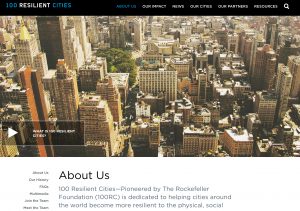
In fact, the plan was a foregone conclusion from the moment the City received a Rockefeller Foundation “Resilient Cities” grant in 2014. Municipal recipients of these grants are expected to produce such a plan. A plan exactly like the one passed by the Council in January had already been rubber stamped by an under-the-radar, Staff-selected “Community Advisory Committee” headed-up by none other than current Dallas Mayoral candidate Regina Montoya and including other Mayoral candidate Michael Solis organized three years earlier. That committee – with no one from local environmental groups as members, much less leaders – released their report last June.
As it turns out, there was a years-in-the-making, Staff-scripted path to a climate plan long before before the public clamor supposedly was just too much for the City Staff to ignore.
One obstacle remained to reaching the end of that path: how to pay the high costs of this consultant-driven plan. OEQ(R)S’s budget wasn’t large enough to absorb the $500,000 it had cost other cities like San Antonio to do the same kind of plan. Staff couldn’t bring itself to ask the Council to wring money for such an item out of the general budget. Not with Fire and Police pay so low, and pot-holed streets and such. So where could it get a cool half million for its needed pet project?
The city’s dormant plastic bag fund of over a million bucks, that’s where. Money collected from the brief period Dallas was able to charge for plastic bag use before the Council repealed the fee under pressure from Austin was still sitting around, dedicated for use for “environmental projects.” But that money had been there since 2015, and despite calls from groups and citizens for new environmental initiatives of all kinds at the city level, it had not been touched, or even mentioned by City Hall staff as a resource that could be tapped to fund those initiatives.
Until now.
With those other projects asking for money City Staff knew they wouldn’t be able to use the bag fund for their own grant-fulfilling use without a public fight. They needed a public groundswell of support to say, “By-God use that plastic bag money to fulfill the requirements of your Rockefeller grant!” It doesn’t quite have the ring of “Liberté, égalité, fraternité,” but whatever.
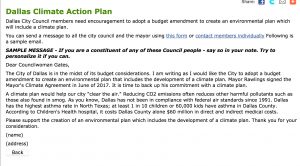 They got a mostly white middle-class version of that by calling on Dallas’ mainline green groups that all have national climate change agendas to lobby for the bag money at the August 2018 budget town hall meetings. These groups bombarded their members with messages to get out and tell their city council representatives the city had to finally take action on climate change. A significant number of them complied. This is the staff-engineered public clamor OEQ(R)S’s McQuire is alluding to in his quote above.
They got a mostly white middle-class version of that by calling on Dallas’ mainline green groups that all have national climate change agendas to lobby for the bag money at the August 2018 budget town hall meetings. These groups bombarded their members with messages to get out and tell their city council representatives the city had to finally take action on climate change. A significant number of them complied. This is the staff-engineered public clamor OEQ(R)S’s McQuire is alluding to in his quote above.
How many of those who showed-up and did the staff’s lobbying for them actually knew how inconsequential the report would be is unknown. Lost in the call for action was any real discussion of what the report would do – and more importantly for residents who want tangible local climate action measures now – what it won’t do.
There was no grassroots consensus, or even discussion, on what priorities that “found” dedicated environmental money could or should be addressing in Dallas, and whether this climate plan was its best use. There was no discussion about what concessions the broader Dallas environmental community could win from the city in return for its support.
City Staff had a self-interest in checking this box for the Rockefellers, and the national mainline groups had a self-interest in justifying their own grants. That’s how Dallas’ environmental policies ended up being decided from the East Coast, instead of you know, Dallas.
THE PLANNING PROCESS: RIGGED FROM THE BEGINNING
Our story begins way back in 2014 when Dallas City Hall’s newly-named chief “Resilience” officer, Theresa O’Donnell began recruiting members to join a special Resilience Report project. Dallas had just won a Rockefeller Foundation “Resilient City” grant that paid for her new job title. It’s the same eager-to-please reason OEQ became an awkwardly-named OEQ(R)S.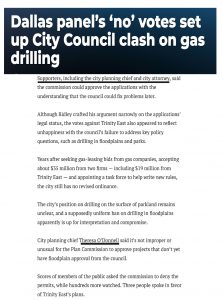
Old-timers will recognize the O’Donnell name from her role in the secret deal giving Trinity East gas drilling rights to Dallas parks and floodplains without the public, or council’s knowledge. Public disclosure of that deal sent City Manager Mary Suhm packing but Suhm minions remained in charge. O’Donnell is a Major Minion. Yes, that’s right. Dallas’ very first “Chief Resiliency Officer” advocated gas drilling in parks and floodplains against overwhelming citizen opposition.
Apparently no lessons were learned by O’Donnell from that episode except maybe to keep things more hidden from public scrutiny.
Dallas’ Resiliency Report 2014-2018
Within a year of the gas drilling debacle, she was hand-picking a committee that would ratify the “Resiliency” goals staff had already identified. O’Donnell applied a light coating of the world famous Dallas-brand Patina of Public Participation – giving the appearance without providing the real thing.
Heading up this Dallas Resilience Report effort was….Theresa O’Donnell, followed by two of O’Donnell’s employees, followed by four Muckity-Mucks from the Rockefeller Foundation, followed by “strategy partner”AECOMM, followed by 15 Dallas City Hall departments, followed by a “Steering Committee” composed of four other O’Donnell/City Hall employees, including OEQ(R)S Director James McQuire and finally someone seemingly from outside of City government – Dr. S. Marshal Isaacs, UT Southwestern Medical Center – except he’s also a city employee because among other duties he’s medical director for Dallas Fire-Rescue.

You have to make your way through 28 names before you get to any mention of Dallas citizens that have no connection to city government or the Rockefellers. That pretty much tells you who’s running the show. But just to make it crystal clear the title of the next grouping of names in the Dallas Resiliency Report is: “Community Advisory Council.” Got that? Here they are, all selected by Theresa O Donnell:
Regina Montoya, Mayor’s Task Force on Poverty (Chair)
Timothy M. Bray, Ph.D., UTD, Institute for Urban Policy Research
Richie Butler, St. Paul United Methodist Church
Teresa Jackson, Sharing Life
Mirjam Kirk, Family Gateway
Cyndy Lutz, Dallas Area Habitat for Humanity
Leonor Marquez, Los Barrios Unidos Community Clinic
Miguel Solis, Dallas Independent School District
Susan Hoff, United Way of Metropolitan Dallas
Elizabeth Sobel Blum, Federal Reserve Bank of Dallas
Dr. Baranda Fermin, Faith in Texas
Michelle Kinder, Momentous Institute
Duane Dankesreiter, Dallas Regional Chamber
Eva Szalkai Csaky, Ph.D., MSF, SMU Hunt Institute
Michael Gagne, appointed by DISD Board President
Cortney Nicolato, The Senior Source
Javier E. Olguin, Ph.D., Dallas County Community College District
Can you spot any Dallas environmentalists or grassroots groups of any kind? Neither can we. All the non-profit organizations are the traditional faith-based ones Dallas City Hall uses as their go-to pool of “community representatives.” Safe, non-confrontational, and unlikely to buck staff. Also unlikely to know a lot about the local case fo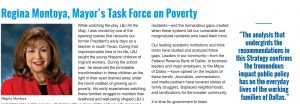 r climate change action.
r climate change action.
Whether Ms. Montoya, Mr. Solis and the other members of this Committee knew they were being used by Staff to pass their already-agreed upon agenda or just went along for the ride is unknown. Neither choice inspires confidence in her or Mr. Solis’ leadership abilities.
Next comes a gaggle of participants with the generic title of “Community Engagement,” which if you’ve seen Dallas City Hall in action probably means there were one or two well-catered lunch meetings of O”Donnell invitees who gathered to “Brainstorm” possible strategies over some excellent chicken and Brussel Sprouts..and then never saw staff again. Nevertheless, these cattle calls do result in excellent fodder for the Appendix in the report. Look, there are so many Engagers!
American Heart Association
American Institute of Architects
American Planning Association
AT&T
Atmos Energy
Brunk Government Relations Services
Building Community Resilience
Childcare Group
Children’s Health
Cities for Action
Cities for Citizenship
City University of New York Institute for State and Local Governance
Citymart
City Square
Commit Dallas
Communities Foundation of Texas
Community Council of Greater Dallas
Dallas Area Rapid Transit
Dallas Citizens Council
Dallas County
Dallas County Community College District
Dallas County Health and Human Services
Dallas County Medical Society
Dallas Faces Race
Dallas Housing Authority
Dallas Independent School District
Dallas Innovation Alliance
Dallas Regional Chamber
Dallas Women’s Foundation
Dallas Youth Commission
Dallas Truth, Racial Healing and Transformation
Dallas-Fort Worth Hospital Council
Downtown Dallas, Inc.
Earth Day Texas
Federal Reserve Bank of Dallas
Friendship-West Baptist Church
Greater Dallas Planning Council
Habitat for Humanity
Harvard Kennedy School Government Performance Lab
Health and Wellness Alliance for Children
Heritage Oak Cliff
Lyda Hill Foundation
Mayor’s LGBT Task Force
Mayor’s Task Force on Homelessness
Mayor’s Task Force on Poverty
Milken Institute School of Public Health
National Association of City and County Health Officials
Neighbor Up
New Americans Campaign
New American Economy
North Central Texas Council of Governments
North Central Texas Regional Emergency Managers Group
North Central Texas Trauma Regional Advisory Council
North Texas Commission
North Texas Fair Housing Center
North Texas Food Bank
North Texas Tollway Authority
Oak Cliff Chamber of Commerce
Oncor Electric
Parkland Center for Clinical Innovation
Parkland Health and Hospital System
Paul Quinn College
Regional Transportation Council
Revitalize South Dallas Coalition
Richardson Independent School District
San Diego State University National Center for Urban School Transformation
SMU Embrey Human Rights Program
SMU Hunt Institute for Engineering and Humanity
Society of American Military Engineers
Southern Methodist University
Southfair Community Development Corporation
Texas A&M AgriLife Research
Texas Department of Transportation
Texas Trees Foundation
Texas Workforce Solutions of Greater Dallas
The Institute for Urban Policy Research at University of Texas at Dallas
The Nature Conservancy
The Senior Source
Toyota Mobility Foundation
Trinity Park Conservancy
Trust for Public Land
U.S. Environmental Protection Agency
U.S. Green Building Council Texas Chapter
United Way of Metropolitan Dallas
University of North Texas
University of Texas at Arlington
University of Texas at Austin
UTA Center for Transportation Equity, Decisions & Dollars
Welcoming America
Welcoming Plan Task Force
Remember, these are just folks invited to brainstorming sessions, not the precious “Advisory Committee.” But not even one local professional or community environmentalist or group is included. Not even the mainline ones Staff would later use to sell the recommendation for a climate action plan to the Council. And certainly not the ones that had just helped defeat the gas drilling deals O”Donnell had advocated.
And no, EDX, the Green Buildings Council, Texas Trees Foundation, and The Nature Conservancy don’t count. EDX is a network not an advocacy group. Green Building Councils are great but those architects aren’t representing any Dallas neighborhoods, and again, not an advocacy group. The national and Austin conservation-focused groups aren’t based in Dallas or do much, if any work in neighborhoods here. One thing they do have in common is that they’re all among Theresa O’Donnell’s circle of friends in other city projects, providing her with a light green patina without having to have the real thing.
It’s really not that hard to put together a list of environmental and citizens group doing climate change work on the ground in Dallas. They’re aren’t that many, and unlike a lot of the names on that long Resiliency Report list, people have actually heard of them.
BTW, at the same time O’Donnell was tapping her nature-loving friends at the Nature Conservancy for this “engagement’ she was also lining them up for the dubious “Breathe Easy” nine school air monitoring project the city is pushing as its one and only “air monitoring project.” No public debate on whether that was the best project, no call for RFPs among the Dallas environmental scene. Just a decision made on behalf of her friends in her office.
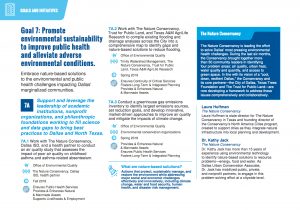
Under the mirage of manufactured consent, O’Donnell’s Resiliency Report was spit out in June of last year. It has a myriad of lofty goals including # 7: “Promote environmental sustainability to improve public health and alleviate adverse environmental conditions.”
But if like us, your mind is racing to all the things Dallas City Hall could be doing to meet that goal when you first hear it, you’ll be disappointed at the very low bar the report sets. Maybe if they’d had someone who knew abut the current “adverse environmental conditions” in the city it would have helped.
Recommendation #1. “Work with The Nature Conservancy, Dallas ISD, and a health partner to conduct an air quality study that assesses the impact of poor air quality on childhood asthma and asthma-related absenteeism. Office of Environmental Quality, The Nature Conservancy, and Dallas ISD, Fall 2018.”
Nobody from outside the O’Donnell bubble is involved. The projects, down to the specific organizations, have already been decided by staff. Like clockwork this project hit the Council in the fall of 2018 and is underway.
We’re sure this project sounded like a splendid idea to everyone on the Advisory Committee and among the (barely) Engaged. Unbeknownst to them there were other options available to Dallas for more widespread and useful air monitoring research but nobody got to hear those because they were being sponsored by what staff described as “biased groups,” i.e. grassroots groups like Downwnders at Risk who’ve been hostile to the staff over its advocacy of pollution permits in West and South Dallas. Only those groups who are in agreement with City Hall staff are allowed for consideration in formulating city policies. Much tidier that way.
Recommendation #2. “Work with The Nature Conservancy, Trust for Public Land, and Texas A&M AgriLife Research to compile existing flooding and drainage analyses across the City into a comprehensive map to identify gaps and nature-based solutions to reduce flooding.”
See a pattern? But you’re really here for this:
Recommendation 3. “Conduct a greenhouse gas emissions inventory to identify largest emissions sources, set reduction goals, and develop innovative, market-driven approaches to improve air quality and mitigate the impacts of climate change. Spring 2018.”
A Dallas climate plan was so far along inside City Hall by last spring that O’Donnell’s Resiliency Report in June of 2018 could confidently report it as a done deal. (And BTW, that was it. They could only think of three ways to “Promote environmental sustainability to improve public health and alleviate adverse environmental conditions in Dallas.”)
But please note the climate plan didn’t go before the Council in the spring of 2018, or the summer, or the fall. It was January 2019 until this “done deal” made it for a final Council vote. Why? Because it wasn’t done. Staff needed to figure out a way to pay for it.
And suddenly that’s when the mainline green groups they’d previously ignored became important to them. However much they talked up the Nature Conservancy, they knew it didn’t represent Dallas environmentalists and could not pull off the kind of sales job they needed. As a result, the Staff helped engineered the “public outcry” they later cited as a reason for passing the plan.
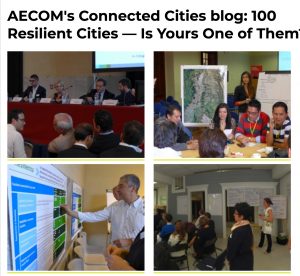 Oh, and the company that got the contract for drafting Dallas’ climate action plan? It was Theresa O’Donnell’s old “strategy partner” AECOM, a consulting firm spun off from…wait for it…oil giant Atlantic Richfield. Yes, that’s right. Dallas’ climate plan is being written by a firm founded as a subsidiary of one of the world’s fossil fuel giants.
Oh, and the company that got the contract for drafting Dallas’ climate action plan? It was Theresa O’Donnell’s old “strategy partner” AECOM, a consulting firm spun off from…wait for it…oil giant Atlantic Richfield. Yes, that’s right. Dallas’ climate plan is being written by a firm founded as a subsidiary of one of the world’s fossil fuel giants.
Now that it really is a done deal, there are at least two important questions to ask of this Dallas climate planning process:
1) What will it actually deliver to the public and Council?
and,
2) What’s the process for “community engagement” from now to release of the plan next year?
INVENTORYING THE DELIVERABLES
What will Dallas get for $500,000?
One thing it will not get is any immediate action on any item that could reduce climate change pollution.
As the plan was being sold to the public and Council, some extreme claims were made about its impact. One advocate stated that “This plan will have huge positive health impacts, saving lives and improving our quality of life. It will make Dallas a better place to live and work, and more attractive to new and clean businesses and jobs, all while reducing Dallas’s greenhouse gas emissions and putting Dallas in the ranks of other world-class cities doing so.”
No it won’t. It can’t do any of that. It can recommend measures that might produce those results, but the report is specifically designed NOT to set in motion any specific policy change on any specific timeline.
It only does two things:
1. Estimate the amount of very specific climate change gases (not even all air pollution) coming from City of Dallas operations, and then tries to do the same thing for the entire City of Dallas.
2. Make recommendations for measures to reduce climate change emissions from municipal and community sources and/or mitigate their impact.
If they’re any good, those recommendations will then need to find a sponsor on the City Council and have at least seven other Council allies willing to pull the trigger. None of that is guaranteed to happen. You could have a report whose worthy goals are disowned by a majority of the Council for years.
In its own anti-climatic words, here what staff says itself about the end results of the plan:
• Use GHG emissions inventory data in development of Comprehensive Environmental Climate Action Plan (CECAP)…. building on the Resilient Dallas plan…
• Continue to encourage City emissions reduction initiatives and conduct emissions monitoring.
Town Hall passions of the advocates outstripped the reality of what this plan can do on its current course.
Any of the environmental groups Theresa O’Donnell hasn’t invited to participate to date could give you a good list of climate change action items right now – free of charge. Again, not that hard since there’s a known universe of options already from the half-dozen or so previous climate plans other cities have produced – courtesy of AECOM and their consulting brethren, who’ve been only too happy to charge officials for some of the most expensive photocopy jobs in history.
SAN ANTONIO EXAMPLE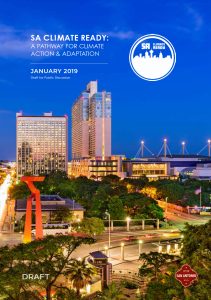
And now there’s some proof those groups’ lists for Dallas City Council climate change action items really would likely be more aggressive and transformative than any list AECOM is likely to produce next year: San Antonio.
San Antonio is to Dallas on climate change as Dallas is to San Antonio on shopping. They’re in whole other leagues.
San Antonio has a progressive mayor who’s made climate change a big local issue. They were out in front before any other major Texas city. The city’s public utility company committed $500,000 two years ago to pay for a climate plan that does the same thing Dallas’ will do. The process there included dozens of community activists who did actually know something about the local “adverse environmental conditions.” Its climate plan was written by a consultant not named AECOM. San Antonio has won all kinds of awards for being pro-active on climate change, including a huge Bloomberg Foundation grant, one of only 25 given to American cities.
Time and again during the push in Dallas to get a local climate plan going, San Antonio was the example being used. They did it right in the Alamo City, we were told. We need to follow their lead.
And yet the final San Antonio plan, recently released, is being criticized by those same mainline groups that advocated Dallas going down exactly the same path only last month.
“The draft SA Climate Ready plan is out and its not what we hoped for. It’s time for San Antonio residents to speak up and demand real action to reduce greenhouse gas emissions at a pace that will preserve a livable climate.”
Examples of disappointment in the report abound. While Chinese cities enjoy full electric transit fleet service in 2019, and Los Angles, Vancouver and other cities have pledged to do the same by 2035, the San Antonio consultant wants to give the city until 2050. Other equally uninspiring options follow. Any climate change organizer could have done better.
So yes, by all means, let’s follow San Antonio’s lead and produce a report that doesn’t deliver desperately needed urgent recommendations or timelines.
But of course these are exactly the kind of feel-good, not-too-challenging goals Dallas City Hall loves to publicize…and then forget about. What will keep the climate plan process in Dallas from producing the same bromides, especially given how it was created?
Maybe the folks that weren’t invited to the table finally come knocking at the door.
THE PROCESS FROM THIS POINT FORWARD
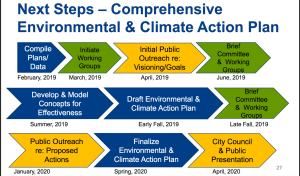
According to the Staff’s timeline, they’re already beginning to decide how to form what they’re calling “Working Groups” to consult with the consultant. How will the membership of these Working Groups be decided, and by whom? At a recent community networking meeting where an OEQ(R)S staffer showed-up, he couldn’t answer those questions. But let’s pretend we’re Theresa O’Donnell. Who might she invite from the environmental side of things?
The Nature Conservancy for sure. The Trees Foundation. EDX. Those are givens. Next comes mainline green groups who won her the support she needed to take money from the City’s only dedicated environmental fund.
Anyone after those usual suspects? What about representatives from local groups most impacted by climate change and adverse environmental conditions now? The Joppa Freedmans’s Township Association, West Dallas One, The Highland Hills Community Group forming around the Lane Plating Superfund site, North Texas Transit Riders, The 10th Street District, Inclusive Communities Project, NAACP Health Committee, Society of Native Nations, Beyond Coal/Dallas? And maybe the leading clean air group in DFW for 25 years? Don’t hold your breathe.
Besides deciding the membership of the plan’s Working Groups by spring, there’ll be some of those “brainstorming sessions” and then a back and forth in the process between consultants and Working Groups that lasts up until the plan’s scheduled release in April of next year (to be unveiled at that 2020’s EDX no doubt). These Working Groups will be the crux of the public participation part of the plan.
What kind of decision is made is determined by how that decision is made and who makes it. The first sign of whether Dallas new climate plan will follow Old Dallas ways is how the staff picks who’s eligible to serve on those Working Groups.
INJECTING “EQUITY” INTO THE PROCESS
Regardless of who staff names to the official process, the groups that have the most to lose from climate change might want to intervene in its drafting, with or without an invitation.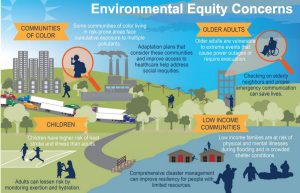
That’s because besides the contortion of titles it causes cities who get their grants to go through, the Rockefeller “Resilient Cities” effort puts a lot of rhetorical emphasis on “equity.”
This is why, even as the OEQ(R)S officially approves new industrial sites in West and South Dallas one after another, it then sends staffers to community meetings to speak about the need to reduce the number of black kids with asthma. It now must tow the Rockefeller “equity” line, in words if not deeds.
Job One in O”Donnell’s Resilient City Report was to “Advance equity in City government” and recommended partnering “with anchor institutions and community-based efforts to advance equity initiatives across Dallas by recognizing and reconciling a history of inequity and fostering communication of social differences between diverse communities and individuals.”
Disparities in Dallas pollution burdens are certainly one of the variables that can impact a neighborhood’s quality of life. But so far the city has gone out of its way to exclude the groups and individuals who suffer from those disparities and/or work on their behalf to address them.
Residents may have a chance to change that behavior. Environmental Justice, aka “Equity” is now a rhetorical challenge for Dallas to live up to in order to justify its Rockefeller money. Future grants and job titles could be imperiled if Dallas isn’t seen as being responsive enough to its Black and Brown populations. That gives citizens who want real reform some leverage with they don’t usually have.
Who do the crop of Mayoral and Council candidates, including Ms. Montaya and Mr. Solis, think should be represented in those climate plan Working Groups? Who are the incumbent council members recommending for membership on those Working Groups? Are they even being asked? What should the Working Group agendas be? What effective, real, climate change responses can we do right now without waiting for a plan to come out in a year and tell us?
Despite its business-as-usual origins, this climate planning process is still an opportunity to test just how “equitable” Dallas politics and City Hall really want to be. But it’s up to residents themselves to administer that test.
Otherwise this time next year all Dallas will likely have to show for its $500,000 is another splashy roll out.
Electric Buses: A Big Climate Change and EJ “Something You Can Do Now”
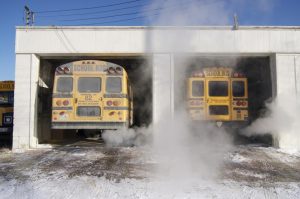
Register for the Electric Glide Bus Pub Crawl here.
Thursday, December 6th
Catch the bus at 6:30 or 7:00 pm
at the Green Door in the Farmers Market District
600 South Harwood Dallas 75201
Plug In. Get Lit. Stay Current.
How did we get from cement plants burning hazardous waste in Midlothian to transit or and school buses making runs in inner city Dallas?
The answer is PM, Particulate Matter. The two-decade fight against the cement plants was one long primer on PM pollution. They were, and remain the largest industrial sources of the pollution in North Texas. We learned firsthand about the toxicity, reach, and insidious health effects of PM pollution. Not just strokes and asthma, but IQ loss, Autism, Dementia, Diabetes, low-weight births. PM is the new lead.
Every boiler, furnace, fire, flame and combustion engine produce PM. Diesel engines emit an exceptionally toxic form of PM called Black Carbon.

Because they’re on the road so much, are diesel or natural gas-powered, and make people wait by the side of traffic-heavy roads to ride, bus systems turn out to be a major source of PM pollution. And climate change gases. And smog. A rough estimate shows DART’s bus fleet would be the 10th largest PM source in Dallas County if it were all parked in one spot. But of course its the dispersed nature of a bus fleet’s pollution that often makes it more of a widespread threat to public health than a stationary “point source” a.k.a. an industrial facility.
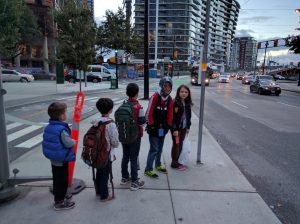
What’s missing is a constituency for electrification of school district bus fleets and transit agencies like DART and Trinity Metro. Because of the potential impacts and benefits, this could be a wide-ranging and powerful alliance – PTAs, transit riders, physicians, environmentalists, environmental justice advocates, and even the utilities that could buy the power from bus batteries. But until we get the ball, er wheel rolling, its all just that – potential.
One of the reasons we’re sponsoring the December 6th “Electric Glide bus pub crawl” as part of this year’s Root and Branch is that we wanted to start that rolling. And real, wheels-on-the-bus-go-round-and-round rolling discussions and presentations on the advantages of electric buses are part of the evening, but so is just showing your support for the goal of electrification as something local officials could accomplish right now, especially if they combine their collective purchasing power.
The more people that show-up on the 6th, the more DART and local school boards – whose memberships we’re inviting as well – will get the impression someone gives a damn and the more we’re a force to be reckoned with. We need a people’s lobby for 21st Century electric buses in DFW.
 In exchange for coming out and forking over $25, we give you three custom drinks, Graham Dodds’ food, a presentation by Dale Hill, the co-founder of the Proterra electric bus manufacturer, and maybe, just maybe some food for thought about what we all can do right now to advance a bunch of causes in one campaign that’s winnable at the local level in the Trump era.
In exchange for coming out and forking over $25, we give you three custom drinks, Graham Dodds’ food, a presentation by Dale Hill, the co-founder of the Proterra electric bus manufacturer, and maybe, just maybe some food for thought about what we all can do right now to advance a bunch of causes in one campaign that’s winnable at the local level in the Trump era.
Register for the Electric Glide Bus Pub Crawl here.
Thursday, December 6th
Catch the bus at 6:30 or 7:00 pm
at the Green Door in the Farmers Market District
600 South Harwood Dallas 75201
Plug In. Get Lit. Stay Current.
Brown, Big: 1971-2018
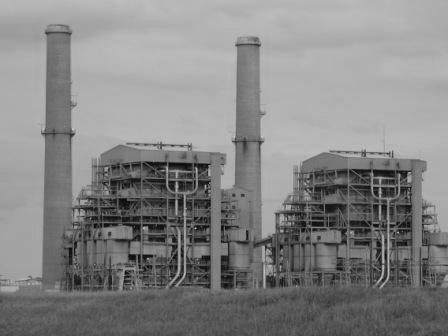 After years of declining fiscal health, the Big Brown lignite coal plant finally succumbed last Friday. An announcement was made by its most recent caretaker, Vistra Energy last Friday morning. The cause of death was obsolescence. It was 47.
After years of declining fiscal health, the Big Brown lignite coal plant finally succumbed last Friday. An announcement was made by its most recent caretaker, Vistra Energy last Friday morning. The cause of death was obsolescence. It was 47.
Controversial from its birth, the 1. 2 Gigawatt Big Brown lived up to its name and was Texas Utilities’ flagship power plant for decades. It began by burning 100% Lignite Coal, the mud-like fossil fuel native to East and Central Texas. By the end however, it was importing thousands of tons of “cleaner” Wyoming Powder Basin Coal in long freight trains to comply with interstate pollution rules.
Along with other coal-fired power plants in East Texas, Big Brown was citied for causing acid rain to by SMU Chemist George Crawford as early as the 1980’s. It was then discovered to be a major contributor t0 Dallas-Fort Worth smog, a fact reinforced by a 2008 study from another SMU professor and former EPA Regional Administrator Dr. Al Armendriz, and more recently by Dallas Medical Society’s Dr. Robert Haley in his 2015 report on ozone levels and public health in DFW. Public Citizen/Texas and the Sierra Club had been particularly hostile to the plant’s continued operation.
As coal lost favor as an energy source, Big Brown’s estimated lifespan had been the subject of countless rumors over the last decade. Towards the end the plant consistently refused modern technology which might have prolonged its life, such as Sulfur Dioxide scrubbers and Selective Catalytic Reduction for smog pollution.
The timing of the plant’s demise was seen as a major embarrassment to officials in the Trump Administration, who’ve promised to promote coal. On the same day as Vistra’s notice about Big Brown’s demise, Trump appointed known fossil fuel promoter Kathleen Hartnett White to lead the White House Council on Environmental Quality.
It was the third Texas coal plant to expire in less than a week. Big Brown was preceded in passing by the Monticello lignite plant, which announced its departure on October 6th. Vistra said its smaller Sandlow power plant near Bastrop was to be closed in 2018 as well.
In 2016, these three coal plants emitted a total of 166 million pounds of sulfur dioxide, 24 million pounds of nitrogen oxide, and 21 million tons of carbon dioxide pollution. Their absence during the 2018 “ozone season” could be the first time DFW stands a chance of complying with the Clean Air Act in 27 years.
Survivors, for now, include the coal-fired Martin Lake and Oak Grove power plants, as well as NRG’s Limestone power plant, southeast of DFW.

